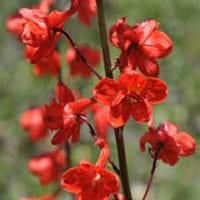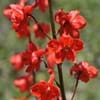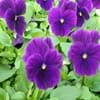Life Span
Perennial
Annual and Perennial
Type
Flowering Plants, Ornamental Plants, Shrubs
Tree
Origin
Africa
Northeastern United States, Mid-Atlantic United States, Southeastern United States, Canada
Types
Not Available
Not Available
Number of Varieties
Not Available
Habitat
gardens, meadows
Deep, Fertile bottom land, Hilly upland habitat, Well Drained
USDA Hardiness Zone
Not Available
6-9
Sunset Zone
Not Available
2a, 2b, 3a, 3b, 4, 5, 6, 7, 8, 9, 14, 18, 19, 20, 21
Habit
Upright/Erect
Oval or Rounded
Minimum Width
Not Available
Flower Color
Red, Rose
Purple, Burgundy, Brown
Flower Color Modifier
Bicolor
Bicolor
Fruit Color
Non Fruiting Plant
Yellow, Green, Yellow green, Brown
Leaf Color in Spring
Green
Green, Dark Green
Leaf Color in Summer
Light Green
Green, Dark Green
Leaf Color in Fall
Green, Yellow green
Yellow, Copper, Orange Red
Leaf Color in Winter
Green, Light Yellow, Tan
Not Available
Leaf Shape
Palmate and toothed
Oblong
Plant Season
Spring, Summer, Fall, Winter
Spring, Summer, Fall
Sunlight
Full Sun, Partial Sun
Full Sun, Partial Sun, Partial shade
Type of Soil
Clay, Loam, Sand
Clay, Loam, Sand
The pH of Soil
Acidic, Neutral, Alkaline
Acidic, Neutral
Soil Drainage
Well drained
Average
Bloom Time
Not Available
Early Spring, Spring
Tolerances
Heat And Humidity
Not Available
Where to Plant?
Ground, Pot
Ground
How to Plant?
Seedlings, Stem Cutting
Seedlings, Transplanting
Plant Maintenance
Medium
Medium
Watering Requirements
It cannot sustain wet-feet, Keep ground moist, Requires regular watering, Water more in summer
Requires regular watering, Requires watering in the growing season, Water Deeply
In Summer
Lots of watering
Lots of watering
In Spring
Moderate
Moderate
In Winter
Average Water
Average Water
Soil pH
Acidic, Neutral, Alkaline
Acidic, Neutral
Soil Type
Clay, Loam, Sand
Clay, Loam, Sand
Soil Drainage Capacity
Well drained
Average
Sun Exposure
Full Sun, Partial Sun
Full Sun, Partial Sun, Partial shade
Pruning
Cut away fading foliage, Do not prune during shooting season, Remove damaged leaves, Remove deadheads
Remove damaged leaves, Remove dead branches, Remove dead leaves, Remove dead or diseased plant parts, Requires little pruning
Fertilizers
High-phosphorous fertilizers used, Organic Flower Fertilizer
Magnesium sulphate, Nitrogen, Phosphate, Phosphorous, Potassium
Pests and Diseases
Bacterial leaf spot, fungus, Mealybugs
Red blotch
Plant Tolerance
Heat And Humidity
Not Available
Flower Petal Number
Single
Single
Foliage Texture
Fine
Coarse
Foliage Sheen
Matte
Matte
Attracts
Butterflies
Birds, Butterflies
Allergy
Severe allergen, Skin irritation, Skin rash, Throat itching, Vomiting
breathing problems, Dizziness, Itchiness, Nausea, Rash, Stomach pain, Swelling
Aesthetic Uses
Beautification, Borders, Showy Purposes, Used for decorating walls, fences, gates, hedges, etc.
Not Used For Aesthetic Purpose
Beauty Benefits
No Beauty Benefits
Good for skin and hair, Skin cleanser
Environmental Uses
Air purification
Air purification, Shadow Tree
Medicinal Uses
No Medicinal Use
Malaria, Rheumatism, Urine infections, Vomiting
Part of Plant Used
Flowers
Flowers, Fruits, Leaves
Other Uses
Used in making blue ink
Making Shampoo, Used As Food, Used for its medicinal properties
Used As Indoor Plant
No
No
Used As Outdoor Plant
Yes
Yes
Garden Design
Edging, Feature Plant
Edible, Feature Plant, Fruit / Fruit Tree, Mixed Border, Shade Trees
Botanical Name
Delphinium cardinale
ASIMINA triloba
Common Name
Scarlet larkspur, Cardinal larkspur
Pawpaw
In Hindi
लाल रंग Delphinium
गंदा संयंत्र
In German
Scarlet Delphinium
Papaya Pflanze
In French
Scarlet Delphinium
usine de papaye
In Spanish
Scarlet Delphinium
planta de la papaya
In Greek
Scarlet Δελφίνιο
φυτό pawpaw
In Portuguese
Scarlet Delphinium
planta mamão
In Polish
Scarlet Delphinium
pawpaw roślin
In Latin
Delphinium coccino
quince herba
Phylum
Tracheophyta
Magnoliophyta
Class
Magnoliopsida
Magnoliopsida
Order
Ranunculales
Magnoliales
Family
Ranunculaceae
Annonaceae
Genus
Delphinium
Asimina Adans
Clade
Angiosperms, Eudicots
Angiosperms, Magnoliids
Tribe
Not Available
Not Available
Subfamily
Not Available
Not Available
Number of Species
Not Available
Importance of Scarlet Delphinium and Pawpaw
Want to have the most appropriate plant for your garden? You might want to know the importance of Scarlet Delphinium and Pawpaw. Basically, these two plants vary in many aspects. Compare Scarlet Delphinium and Pawpaw as they differ in many characteristics such as their life, care, benefits, facts, etc. Every gardener must at least have the slightest clue about the plants he wants to plant in his garden. Compare their benefits, which differ in many ways like facts and uses. The medicinal use of Scarlet Delphinium is No Medicinal Use whereas of Pawpaw is Malaria, Rheumatism, Urine infections and Vomiting. Scarlet Delphinium has beauty benefits as follows: No Beauty Benefits while Pawpaw has beauty benefits as follows: No Beauty Benefits.
Compare Facts of Scarlet Delphinium vs Pawpaw
How to choose the best garden plant for your garden depending upon its facts? Here garden plant comparison will help you to solve this query. Compare the facts of Scarlet Delphinium vs Pawpaw and know which one to choose. As garden plants have benefits and other uses, allergy is also a major drawback of plants for some people. Allergic reactions of Scarlet Delphinium are Severe allergen, Skin irritation, Skin rash, Throat itching and Vomiting whereas of Pawpaw have breathing problems, Dizziness, Itchiness, Nausea, Rash, Stomach pain and Swelling respectively. Having a fruit bearing plant in your garden can be a plus point of your garden. Scarlet Delphinium has no showy fruits and Pawpaw has showy fruits. Also Scarlet Delphinium is flowering and Pawpaw is flowering. You can compare Scarlet Delphinium and Pawpaw facts and facts of other plants too.





